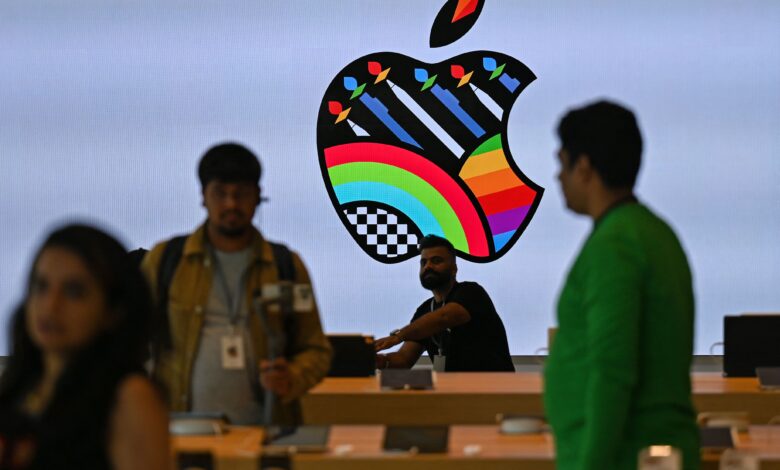Government Declares Apple Inc. India’s Journey As Top Job Creator, Credits PLl Scheme; A Highlight To Be Scored On Ahead Of General Elections?
The Indian government has declared Apple Inc.'s significant role as a top job creator in India, credited to the Production-Linked Incentive (PLI) scheme, thus marking a noteworthy milestone just ahead of the general elections. The recognition comes even as Apple seeks to diversify its operations from China, where it was a key contributor to employment generation.

The Indian government has declared Apple Inc. as a top job creator in India, attributing this achievement to the Production-Linked Incentive (PLI) scheme.
The declaration and the timing can be seen as a significant accomplishment in the lead-up to the general elections.
Since the initiation of the PLI scheme for smartphones in August 2021, the Apple ecosystem has directly employed over 150,000 individuals, making it the largest contributor to blue-collar employment in the country.
Government officials and experts familiar with the matter note that the majority of these employees are young, first-time job seekers aged between 19 and 24.
In addition to these direct employments, an estimated 300,000 people have secured jobs indirectly through the ecosystem.
Companies benefiting from incentives under the PLI scheme are required to report their employment creation data to the government.
According to officials, Apple employs nearly 3,000 individuals in India, while the development of iOS apps supports over 1 million jobs.
![]()
Apple’s expansion in India has been notable. Despite challenges such as geopolitical tensions and downturns in key markets like the US and China, the company has intensified its focus on India, the world’s second-largest smartphone market.
Apple began manufacturing iPhones in India in 2017 and significantly increased local production in alignment with the PLI scheme.
It has collaborated with suppliers to assemble the latest iPhone models through contract manufacturers like Foxconn, Wistron, and Pegatron, while also increasing the production of components domestically.
Last year, Tata Group acquired Wistron’s India unit from its Taiwanese parent, adding to the dynamics of Apple’s manufacturing ecosystem in the country.
According to government data, the trio of Foxconn, Wistron, and Pegatron, approved to receive benefits under the PLI scheme, have collectively created over 77,000 direct jobs.
Among them, Foxconn leads with 41,000 jobs, followed by Wistron with 27,300, and Pegatron with 9,200. While Foxconn and Wistron are in their third year of the PLI scheme, Pegatron is completing its second year of operations in India.
Experts anticipate that during the peak June-September period, iPhone factories will directly recruit over 10,000 individuals as production ramps up to three shifts to meet the global demand for the upcoming iPhone models, typically launched in September.
In February, the FY24 production of iPhones surpassed Rs 1 lakh crore, with these devices holding a market value of approximately Rs 1.6 lakh crore, accounting for taxes and dealer margins.
Apple’s production achievements have surpassed the targets outlined in the PLI scheme, positioning the company as potentially the leading phone manufacturer in the country by value, as stated by experts.
In a strategic move, Apple is establishing a vigorous ecosystem of Indian suppliers, including units within Tata, to facilitate a significant portion of production migration from China, currently the primary location for iPhone manufacturing.
This supplier network spans across Tamil Nadu, Karnataka, Uttar Pradesh, Andhra Pradesh, and Haryana. In addition to the three contracted manufacturers, this growing Apple supplier ecosystem has generated over 70,000 new direct employment opportunities, according to officials.
Notable job creators among Apple’s suppliers, based on submitted data, include Tata Electronics, manufacturing enclosures for iPhones in Hosur, and Salcomp Technologies, producing enclosures and power adaptors.
Foxlink and Sunwoda, specializing in cables and batteries for iPhones, are also prominent contributors to job creation. Moreover, Avary Technologies, CCL Industries, and Flex, suppliers of iPhone sub-assemblies and components, have collectively generated several thousand additional jobs.
In line with its commitment to promoting this growing ecosystem, Apple recently launched an educational program focusing on women’s health as part of its $50-million Supplier Employee Development Fund.
China Numbers
Apple has created more than 3 million jobs in China through its supply chain, sourcing, and investment.
The App Store ecosystem for iOS supports more than 1.8 million jobs, and developers in Greater China have earned more than RMB 110 billion from the App Store since its launch.
Despite its significant presence in China, where it has directly employed 14,000 individuals and supports approximately 1.5 million workers in the global supply chain, Apple is aiming to expand its business beyond China.
While China has played a critical role in Apple’s success, including factors like a cost-effective labour force, government incentives for factory construction, and a growing middle class, the company is reportedly exploring diversification strategies mainly because of the Chinese government crackdown.
However, according to Bloomberg Intelligence estimates that, transitioning just 10% of Apple’s manufacturing capacity away from China could take up to eight years.
India Numbers
In the previous year, Apple’s iPhone production in India surpassed ₹1 lakh crore, demonstrating a substantial increase in output compared to the preceding year.
Among these, iPhones manufactured in India, valued at ₹65,000 crore, were exported between January and December.
An official familiar with the situation clarified that the ₹1 lakh crore denotes the Freight on Board (FOB) value, representing the price of the devices as they leave the factory.
However, the actual market value of production could range between ₹1.5 lakh crore and ₹1.7 lakh crore, contingent on taxes and dealer margins across different countries.
FOB signifies the cost of a product at the factory gate, prior to the addition of taxes and other associated charges. Apple emerges as a leading phone manufacturer in India in terms of value.

According to Counterpoint data, the company’s market share in India increased from 2% in FY18 to 6% in FY23, while Samsung’s share decreased from 26% to 20% during the same period.
Apple’s business in India surged from Rs 13,097 crore to Rs 49,322 crore, whereas Samsung’s mobile revenues escalated from Rs 37,349 crore to Rs 70,292 crore.
In FY23, Apple achieved the milestone of being the first standalone brand to surpass the $5 billion export mark from India, primarily driven by iPhone exports.
Notably, total mobile phone exports from India reached Rs 90,000 crore in FY23, with iPhones playing a significant role.
According to Commerce Ministry data, mobile phones propelled the electronics sector to become India’s fifth-largest export category within the first eight months of the current fiscal year.







